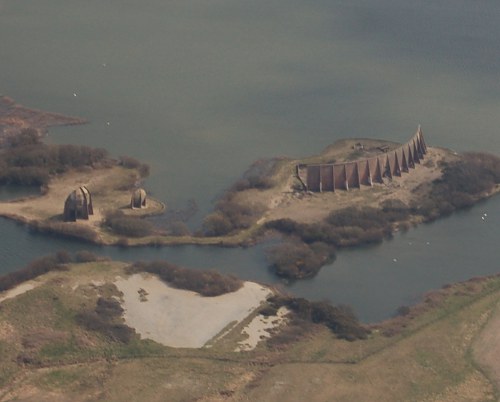It would appear that the “War Heroes” episode of the television programme Great Railway Adventures With Dan Cruickshank featured the Denge sound mirrors.
Sound mirrors
‘Immovable Objects Secret States’ by John Billan
Next John is off to England to to photograph the Sound Mirrors around the Kent area (including the truly astounding Denge sound mirrors – click on the photos below to see a larger version) and to do some recording of the sounds they reflect. I am jealous LOL – they are such amazing structures, what a good find. I can only imagine the sounds and photos that John will get.
[More…]
Diamond Geezer at Abbot’s Cliff
On May 31 Diamond Geezer (who writes a very good London blog) “…found an acoustic sound mirror at Abbott’s Cliff”.
Photos of 2004 Denge sound mirror guided walk
Hywel Williams took some photographs on a guided walk to the Denge sound mirrors on 4 August 2004: Denge Sound Mirrors – “The Listening Ears”.
I could hear the little steam train pass across in front of me off the sound mirror, GREATLY magnified in sound and apparently in the mirror direction it was traveling. Clearly not a demonstration of aeroplane detection, but also a clear demonstration that these concrete mirrors still work, nearly 80 years after their experimental construction!
Ooo, I’m in one of the photos!
Hywel also has a rather good site about Disused stations on London’s Underground.
Conservation techniques and the Denge sound mirrors
… One of the largest projects funded by the Aggregate Levy Sustainability Fund and managed by English Heritage was concerned with stabilizing these structures and undertaking research into their repair.
This paper aims to outline the conservation approach to the project and to detail the concrete repair techniques trialled. It also highlights some pointers for the repair of twentieth-century concrete based on the advice of a master mason and a concrete repair contractor. Finally, the long-term monitoring that is in place for the carbonation inhibitors and cathodic protection systems that are installed on these structures are detailed.
The Listening Mirrors – A Conservation Approach to Concrete Repair Techniques by Alan Wright and Peter Kendall. Journal of Architectural Conservation, Volume 14, Issue 1, March 2008
Andrew Joron and The Sound Mirror
Christopher Nelson’s Poetry Blog has an interview with Andrew Joron, “the metaphysician-elect of contemporary American poetry”, about his book The Sound Mirror.
Nelson: Your title, The Sound Mirror—can you elaborate on that synesthetic paradox? Or would that be to explain away the pleasant mystery?
Joron: In one sense, the idea of a “sound mirror” is not a paradox. Part of the science of acoustics is concerned with the way sound is reflected from surfaces such as the walls of a concert hall. And before the invention of radar, England constructed huge hemispherical “sound mirrors” out of concrete and placed them in open fields as listening devices that would amplify the sound of approaching bombers from Germany. In my case, I appropriated the title from an old Sun Ra LP, which has never been reissued on CD. Sun Ra himself got the title from the first commercially available recording device, released in the forties, which was called The Sound Mirror. But you’re right to note my intent to complicate the sound/light relation in presenting this title. Writing that uses the phonetic alphabet becomes a “sound mirror”; I want to emphasize that, while sound may be exiled from the written word, it continues to haunt the scene—the seen—of writing.
More…
Denge sound mirrors from the air
Ian Ballard has photographed the Denge sound mirrors from a light aircraft.
Denge mirrors at Exploring Kent’s Past
“Acoustic Sound Mirrors at Greatstone-on-Sea, Lydd” at Kent County Council’s Exploring Kent’s Past.
The remains of three large concrete structures, formerly an anti-aircraft Acoustic Detection installation. Microphones were attached to the three reinforced concrete structures in order to pick up the sound of approaching enemy aircraft. The smallest ‘sound mirror’ was found to be fairly ineffective so it was superseded by a larger dish, 12 m in diameter. This in turn was replaced by a 70m long ‘sound wall’. The structures were built by the RAF between 1930-4. They were rendered obsolete by the introduction of radar in 1935, and by advances in aerial technology.
Source: Exploring Kent’s Past
Kent History Forum photos
Sound mirrors on the Kent History Forum. There is lots of other good stuff on the site, too.
- Abbot’s Cliff. Including an aerial photo.
- Denge.
on the last official walk … there was round 300 hundred of us
. - Fan Hole, near Dover.
- Hythe.
- Joss Gap (Kingsgate).
Joss bay had two sound mirrors one being a slab, this was cut into the cliff near by the castle keep hotel , now replaced by flats.a slight indentation can still be seen near the top of the cliff. Checking the site where the round mirror was, which was a timber frame rendered. a few years ago the telephone cable blocks were still in place.
- Warden Point. With a good 1978 photo of it about to go over the cliff.
WWII radar in Malta
Radar stations during wartime Malta, by Charles Debono, curator of the National War Museum in Valletta.
… as radar technology was in its infancy, in Malta, the British authorities decided to build an early-warning system, the Parabolic Acoustic Mirror known as Il-Widna (ear), constructed at Ta’ San Pietru, Maghtab.
Il-Widna became outdated when the British government decided to install the first RDF [Radio Directing Finding] in Malta. It is important to say that this was to be the first RDF installed outside the UK.
More at the Times of Malta website
